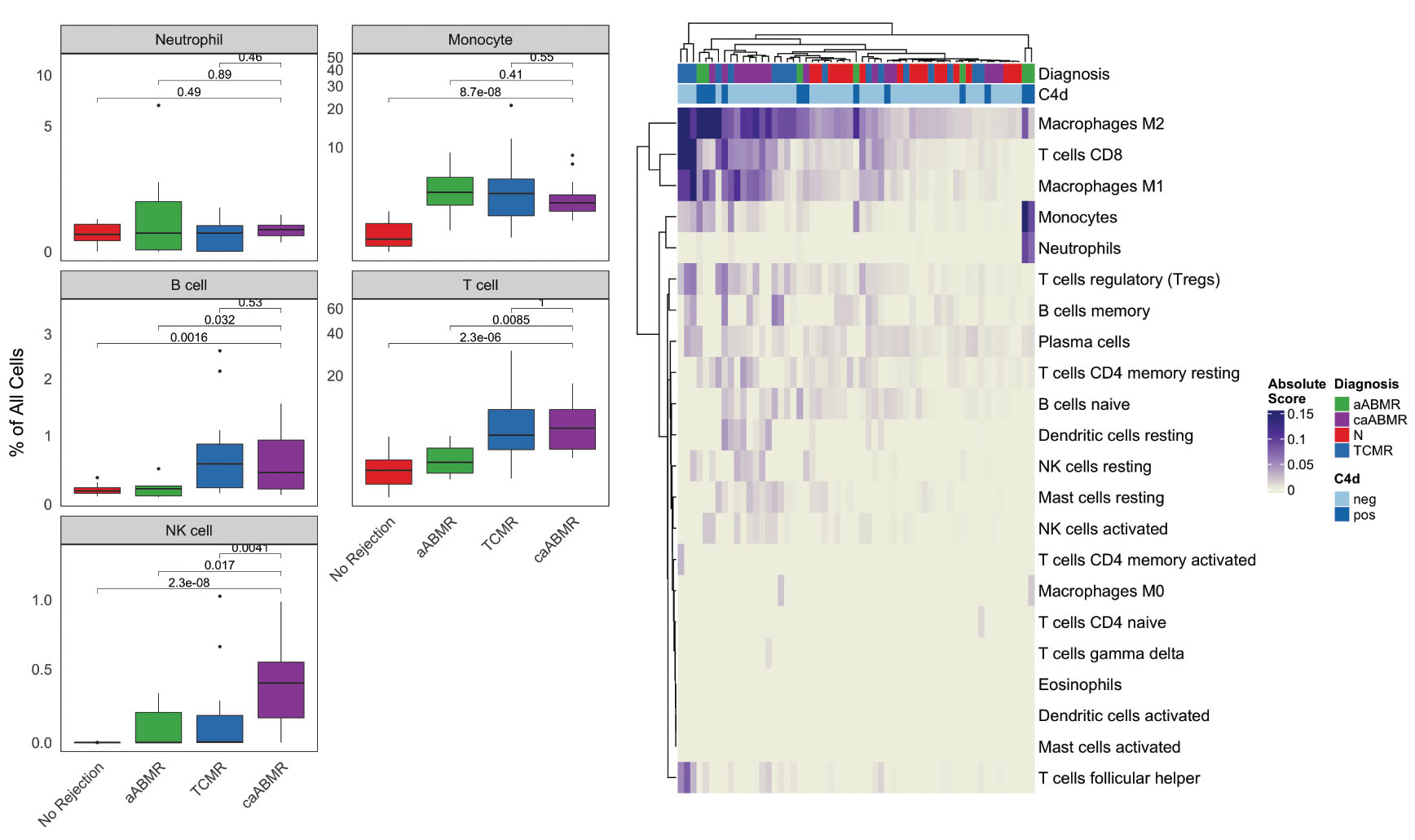RNA-Sequencing Analysis of Kidney Allografts Reveal Heightened NK Cell Activity in Chronic Active Antibody-Mediated Rejection
Weill Cornell Medicine, New York, NY
Meeting: 2022 American Transplant Congress
Abstract number: 193
Keywords: Biopsy, Kidney, Natural killer cells, Rejection
Topic: Basic Science » Basic Science » 08 - Innate Immunity; Chemokines, Cytokines, Complement
Session Information
Session Name: Innate Immunity, Chemokines, Cytokines, and Complement
Session Type: Rapid Fire Oral Abstract
Date: Sunday, June 5, 2022
Session Time: 5:30pm-7:00pm
 Presentation Time: 6:50pm-7:00pm
Presentation Time: 6:50pm-7:00pm
Location: Hynes Room 309
*Purpose: The role of NK cells is increasingly recognized in chronic active antibody mediated rejection (caABMR) of the kidney allograft. Treatment of caABMR is challenging and the allograft prognosis is poor. Identifying unique and shared molecular pathways among caABMR, active antibody mediated rejection (aABMR) and acute T cell mediated rejection (TCMR) may help better understand the mechanism of kidney disease progression in cABMR and develop effective therapeutic strategies
*Methods: We did RNA-sequencing and data analysis of 57 kidney allograft biopsies, stored in RNAlater, obtained from 57 adult kidney transplant recipients. Among the 57 biopsies, 39 were for-cause biopsies done for graft dysfunction and 18 were surveillance biopsies. As per the Banff 2017 classification and reported independently by two pathologists, 15 biopsies were categorized as caABMR, 7 as aABMR, and 17 as TCMR. The 18 surveillance biopsies were categorized as as normal/nonspecific (Normal). Immune cell deconvolution was achieved using two methods – EPIC and MIXTURE. FPKM gene expression values were used as inputs to these algorithms. EPIC deconvolution was run as implemented in the immunedeconv R package and run with tumor=FALSE and scale_mrna=TRUE. MIXTURE was run using the LM22 matrix and run parameters were set to iter=1000, functionMixture=nu.svm.robust.RFE, nullDist=’PopulationBased’.
*Results: The absolute number of NK cells were low in rejection. However, NK cells were increased in caABMR compared to other diagnostic categories (Figure 1). Several key genes involved in the NK cell mediated cytotoxicity KEGG pathways were upregulated in caABMR. Next, we explored genes associated with the complement system and found caABMR—compared to aABMR—was associated with upregulation of early but not late components of the classical complement pathway.
Figure 1. Box plot depicting the proportion of neutrophils, monocytes, B-cells, and T-cells and NK cells in cABMR, aABMR, TCMR, and Normal biopsies. Heatmap depicts the different cell types in these biopsies.
*Conclusions: Our results suggest that caABMR is linked to heightened activation of NK cells and lack of intragraft complement pathway activation. These findings, along with the absence of C4d staining despite the presence of donor specific antibodies in most caABMR biopsies, advance the role of antibody-dependent cellular cytoxicity rather than complement-dependent cellular cytoxicity as the principal mechanism of cellular injury in caABMR.
To cite this abstract in AMA style:
Shah Y, Varma E, Rahim S, Li C, Snopkowski C, Hughes C, Dadhania DM, Salvatore S, Seshan SV, Elemento O, Suthanthiran M, Muthukumar T. RNA-Sequencing Analysis of Kidney Allografts Reveal Heightened NK Cell Activity in Chronic Active Antibody-Mediated Rejection [abstract]. Am J Transplant. 2022; 22 (suppl 3). https://atcmeetingabstracts.com/abstract/rna-sequencing-analysis-of-kidney-allografts-reveal-heightened-nk-cell-activity-in-chronic-active-antibody-mediated-rejection/. Accessed December 24, 2025.« Back to 2022 American Transplant Congress

